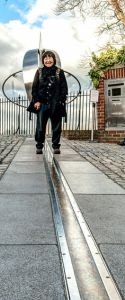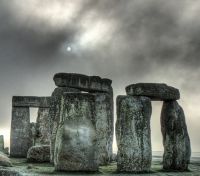
 Prior to viewing the
aurora borealis in Lapland,
we spent several full days exploring London and its
surroundings. Hotels were shockingly pricey in the city, so we stayed at a
hotel at Heathrow Airport. Even after buying two 7-day 6-zone public
transportation (oyster) cards, we came out way ahead, and we loved riding
the underground, light rails, and overgrounds throughout the city.
Prior to viewing the
aurora borealis in Lapland,
we spent several full days exploring London and its
surroundings. Hotels were shockingly pricey in the city, so we stayed at a
hotel at Heathrow Airport. Even after buying two 7-day 6-zone public
transportation (oyster) cards, we came out way ahead, and we loved riding
the underground, light rails, and overgrounds throughout the city.
We spent a day visiting Greenwich, home of the Prime Meridian (0° longitude, see photo at right) and the Royal Observatory, among other sights. The Royal Observatory had many interesting exhibits of old astronomical instruments, the most fascinating being the actual marine timekeepers developed by John Harrison in the 1700s to solve the longitude problem– how to accurately determine longitude at sea.
We took a tour of Stonehenge, Bath, Stratford-on-Avon, and the Cotswolds. Unfortunately, freezing fog set in that day, not only making it the coldest day of the year, but severely limiting visibility throughout the 11-hour tour.
 It did make for some cool, spooky shots of the sun attempting to shine on
Stonehenge. Dave has been experimenting with HDR (high dynamic range)
imaging, which combines a set of bracketed camera exposures into a single
image to show more detail than would be possible in a single shot (which
would be over- or underexposed). Stonehenge in fog was a good application
for HDR.
It did make for some cool, spooky shots of the sun attempting to shine on
Stonehenge. Dave has been experimenting with HDR (high dynamic range)
imaging, which combines a set of bracketed camera exposures into a single
image to show more detail than would be possible in a single shot (which
would be over- or underexposed). Stonehenge in fog was a good application
for HDR.
Dave posted a few of the 10,000 images we took in England and Sweden
here.
We had seen Longitude, the 4-part TV documentary about John Harrison, many years ago, and loved it so much we bought the DVDs. At that time, we thought the parallel story of Rupert Gould's efforts to restore the chronometers was distracting. However, when we rewatched the series after returning from this trip, his storyline was now fascinating! We were also delighted to recognize many areas in and around the Royal Observatory.